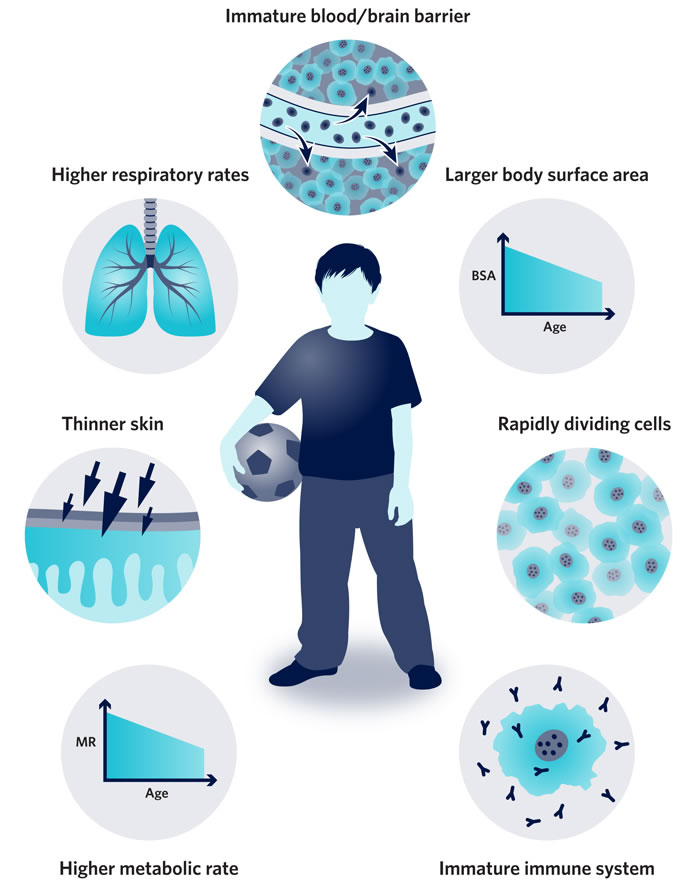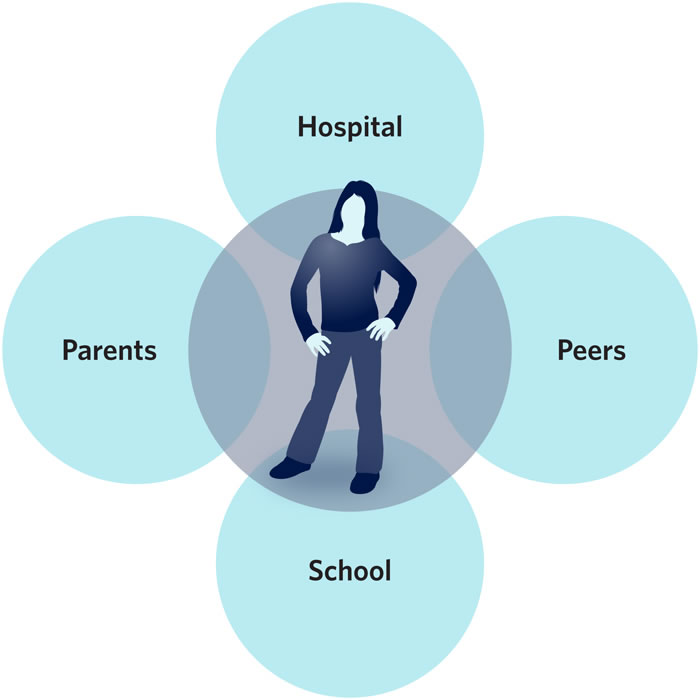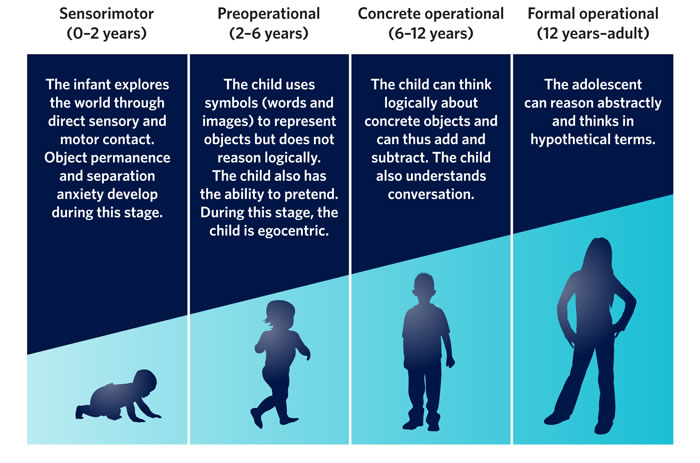This page provides further reading and resources on topics that will assist you in learning more about working in a paediatric healthcare environment:
Differences between children, adolescents and adults
There are a many differences between children, adolescents and adults (physiological, anatomical, cognitive, social and emotional), which all impact on the way illness and disease present in children and young people, as well as the way healthcare is provided. Specialist paediatric training is important because children, adolescents and adults:
- Present with illness differently, so people working with children need the skills and knowledge to identify and diagnose illness in a child or adolescent, and be aware of illnesses specific to different age groups.
- Often require age-appropriate treatments, approaches to treatment and environments.
- Have different contexts:
- Children and adolescents come with family, who generally have a greater role in their wellbeing, so health professionals need to work with family as well as the patient.
- Activities are different for different ages - play becomes less important with age, but the need for stimulation, school and employment in other activities remains important.
- Children and adolescents are still developing, so their responses to similar situations will be different and experiences they have will impact on their future development.
The following sections provide you with an overview of these important differences. You can also learn more about many important aspects of child development by completing the
‘Know Me Early’ online program in the RCH Learning Management System (Learning HERO).
Anatomical/physiological differences

- Larger body surface area (BSA) - Children have a proportionately larger BSA than adults do. The smaller the patient, the greater the ratio of surface area (skin) to size.
As a result, children are at greater risk of excessive loss of heat and fluids and are affected more quickly and easily by toxins that are absorbed through the skin.
- Thinner skin - Children have thinner skin than adults. Their epidermis is thinner and under-keratinized, compared with adults.
As a result, children are at risk for increased absorption of agents that can be absorbed through the skin.
- Rapidly dividing cells - Children's cells divide more rapidly than adults to assist in their rapid rate of growth. As a result, children are more susceptible to the effects of radiation than adults.
- Higher heart rate and respiratory rate - Children have higher respiratory rates than adults. Higher respiratory rates lead to proportionately higher minute volumes. As a result, children may be more susceptible to agents absorbed through the pulmonary route than adults with the same exposure. Children may also respond more rapidly to such agents. Signs and symptoms in children may be an "early warning" of a chemical, biological, or radiological incident.
- Immature blood-brain barrier - Children have immature blood-brain barriers and enhanced central nervous system (CNS) receptivity. As a result, children may exhibit a prevalence of neurological symptoms. Nerve agents may produce more symptoms in pediatric patients, requiring levels of treatment for children that are not indicated for adults with the same level of exposure.
- Higher metabolic rate - Children are more susceptible to contaminants in food or water and are at greater risk for increased loss of water when they are ill or stressed. Medication doses must be carefully calculated based on the child's weight and body size.
- Immature immune systems - Children are at a greater risk of infection and have less herd immunity from some infections.
Psychosocial Differences
Although adults continue to develop psychosocially, their values, behaviours and social circles are generally far more defined and stable compared to children and adolescents who are rapidly developing. Children and adolescents use the world around them and pick up cues from their environment to aid in that development. It is essential to be mindful of the way clinicians interact and communicate with children, adolescents and their families as they play a key role in this development. It is important for clinicians to be well aware of the broader context of a child or adolescent's life, as this has a significant impact on the way they experience and recover from illness or injury.
Social
 Unlike adults, children and adolescents are still in a period of social development which involves learning the values, knowledge and skills that enable them to relate to others. The goal is for children and adolescents is to build a positive sense of their own identity and their role in relationships with people around them. These social skills and lessons can be learnt from those who care for them, as well as indirectly through negotiating social relationships with family or with friends, and through participation in the world around them. Not all relationships and experiences are positive, and the impact of negative influences also shapes social behaviours. It is therefore important for clinicians to be mindful of how they conduct themselves in their social or professional relationships with a child's family and toward the child and adolescent themselves as they have an impact on learning and the development of their own social identity. It is also important to be mindful of different circumstances which shape social skills during the developmental process and influence behaviours and interactions with other people.
Unlike adults, children and adolescents are still in a period of social development which involves learning the values, knowledge and skills that enable them to relate to others. The goal is for children and adolescents is to build a positive sense of their own identity and their role in relationships with people around them. These social skills and lessons can be learnt from those who care for them, as well as indirectly through negotiating social relationships with family or with friends, and through participation in the world around them. Not all relationships and experiences are positive, and the impact of negative influences also shapes social behaviours. It is therefore important for clinicians to be mindful of how they conduct themselves in their social or professional relationships with a child's family and toward the child and adolescent themselves as they have an impact on learning and the development of their own social identity. It is also important to be mindful of different circumstances which shape social skills during the developmental process and influence behaviours and interactions with other people.
Emotional
Children and adolescents are still developing their ability to recognize and manage their emotions or feelings, and this can be influenced by many social and environmental factors. For infants and young children, their emotional bond of affection or 'attachment' to their caregivers is crucial to their emotional development.
Effects of secure attachment include:
- More resilient, competent toddlers with high self esteem
- In pre-school, children display more persistence, curiosity, self-reliance, leadership and have better peer relations
- After age 11 children and adolescents display better social skills, leading to more close friends
Clinicians in a paediatric setting should be mindful of the disruptions that an illness and hospitalisation can have on to this bond. Separation anxiety is emotional distress which can be seen in many infants when they are separated from people with whom they have formed an attachment. Clinicians should also be mindful that not all children and adolescents will come from an environment where they will have the consistency and stability in their everyday lives to allow them to form secure attachments, and this may be reflected in their coping and behaviour whilst in hospital.
Cognitive
Cognition is the growth of thought in children. In a paediatric environment, a clinician must be mindful of how they communicate with a patient, taking into account a child's or adolescent's level of cognitive development. Children typically progress through the following stages of cognitive development:

Adolescence
As well as acknowledging the differences between children and adult populations, it is also important to recognise the specific developmental challenges of adolescence.
Adolescents are generally more able to participate in decision-making about their own care, and have opinions and views which can challenge those of their families and/or health care providers. Therefore, it is necessary to find the most appropriate way to work with each adolescent on an individual basis. This is the case in a paediatric or adult healthcare setting, as adolescents can often be seen in adult environments and feel overwhelmed or insignificant without the opportunity to participate in their own healthcare decisions.
Adolescents can be more inclined to experiment and take part in high-risk behaviours which impact on their health and their response to intervention. Adolescents and children are also more vulnerable as a result of their reliance on others to meet their different needs, and they can be more susceptible to the negative impacts of complex social situations and exploitation as they are not yet fully developed or independent. These factors can have a major impact on their presentation and behaviours, and are also a major factor in planning for discharge/future healthcare and wellness.
Adolescents will eventually transition to adult health-care environments, which can be a vastly different environment with new challenges, new clinics and new staff to meet. It is important to help adolescents prepare for this transition by empowering them to take more responsibility for their own healthcare and enable them to negotiate their way through this new environment.
Summary
As well as the more obvious physiological and cognitive differences between children and adults, working with children and adolescents requires the consideration of future physical, social, emotional and cognitive development, which is of primary importance. The need to be aware of the context in which a child or adolescent lives and functions is crucial for both the provision of appropriate management, as well as planning for future healthcare.
Child rights
All consumers have healthcare rights, regardless of their age. However, the rights of children and young people in healthcare can be a more complex area due to developmental considerations and the involvement of family and carers in the healthcare process. Children and young people do have rights, and these rights need to be respected when providing clinical care.
The following video has been produced by members of our Youth Advisory Council (YAC).
Further resources on child rights and safety:
Patient and family-centered care
Children and young people have a different social context than adults, and their parents and families are the main source of support and advocacy. The importance of working in partnership with the child and family is paramount and the perspectives and input of
the child and family are important in clinical decision making. You can read more about
Patient and Family Centred Care at RCH here.
Effects of hospitalisation on children
Factors including developmental age, separation from their caregiver, removal from their familiar environment and the introduction of unfamiliar people and experiences can impact on the way children and young people cope with hospitalisation.
There are a number of ways the negative effects of hospitalisation can be minimised and children and young people supported to have more understanding and control of their situation.
The following video examines the rigours of hospital from a child's perspective and the role of specialist hospital programs that reduce stress and anxiety.
The following audio program gives an insight into the effects of hospitalisation on children and what health professionals can do about it.